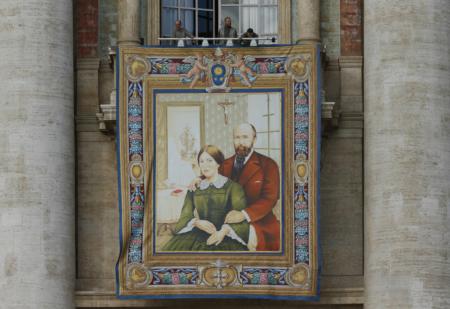The saints and all of us
ROME. Amidst all the Sturm und Drang of Synod-2015, something genuinely new in the life of the Church began, and it shouldn't escape our notice. For the first time in two millennia, an entry in the liturgical books will now read, on the appropriate day, "Saints Louis and Zélie Martin, Spouses" -- a happy addition to "Martyr," "Confessor," "Bishop," "Religious," "Pope," etc, in the pantheon of vocations to sanctity. Spouses: a married couple, together on the tapestry that hung from the central loggia of St. Peter's before, during, and after their canonization on October 18; a man and a woman, a dad and a mom, who were the parents of a saint, the Little Flower, and in whose married life mutual sanctification took place by cooperation with God's grace.
Saints-as-spouses. There was something for Synod-2015 to ponder. And if insufficient attention was paid to this during the Synod, that's no reason for the Church, in which millions of spouses are living lives of heroic virtue, not to take notice -- and to reflect upon some old truths about the "canonization" of saints.
The Church doesn't canonize saints for their sake. God takes quite good care of his holy ones, we may be sure, and being "raised to the dignity of the altars," as the old phrase had it, does nothing for those so raised. No, the Church canonizes saints for our sake, so that we might have models who inspire us to be the holy ones we must be, if we're to fulfill our Christian and human destiny. That's why the Church sings the Litany of the Saints at its most solemn liturgical celebrations: the Litany of the Saints is the Church's family album, the roster of those who form that "great cloud of witnesses" of which the author of the Letter to the Hebrews speaks so eloquently.
Another old truth worth repeating, with the holy spouses of the Martin family in mind, is that the Church doesn't "make saints;" God makes saints, and the task of the Church, through the beatification and canonization process, is to recognize the saints that God has made. The process by which that recognition takes place has changed over time, from something resembling an adversarial legal procedure to something more akin to a doctoral seminar in history. The object of the exercise remains the same, though: to sift through the record of a life in order to find the traces and tracks of grace at work -- as it is in all of us.
The lives of the holy spouses of Lisieux are also a great witness to the incredible capacity of the Catholic Church for self-renewal.
Louis Martin was born in 1823; Zélie was born eight years later. In other words, both were born a generation after the utter devastation of the French Church by the French Revolution. After the enforcement by state power of the Religion of Reason and the bloody slaughters of the Reign of Terror (a spasm of lethal Gallic craziness musically evoked by Francois Poulenc's Dialogues of the Carmelites), who would have predicted that 19th-century France would be a seedbed of mission and sanctity, the effects of which would be felt from the hitherto-obscure village of Lourdes in the French Pyrenees to Francophone Africa to Oceania?
Yet it happened. Much of what we think of as "French Catholicism" today grew out from under the rubble of the Terror and the destruction of the Church of the ancien régime. Louis and Zélie Martin, and their daughter, the Doctor of the Church who gave Catholicism the "Little Way," were all products of that astonishing flourishing of holiness and evangelical zeal that followed immediately after a period of unprecedented destruction. How did that happen? It happened because, life by life, men and women took the risk of fidelity. Ordinary people defied the claims of their putative ecclesiastical betters -- too often heard during Synod-2015 -- that asking the heroic is just too much.
No, it's not. Summoning us to lives of heroic virtue is asking us to be the saints we -- like Saints Louis and Zélie Martin, Spouses -- were baptized to be.
- George Weigel is Distinguished Senior Fellow of the Ethics and Public Policy Center in Washington, D.C.



















